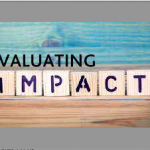SROI (Social Return On Investment) and its application to Erasmus Plus
A few weeks ago, we discussed the utility of using the Theory of Change to analyze social impact in the context of Erasmus+ Projects. The feedback was very positive, so now we want to go deeper on the topic with the method “Social Return On Investment”. SROI can be useful to quantify the analysis, associating a financial value to the impact achieved.
Understanding the basics
As we mentioned in the previous article, impact can be defined as the long-term effect of the outcomes. This means that impact can be positive, but also negative; it can be expected or unexpected; directly produced by your intervention or maybe not so much.
When using SROI, you want to define it as the differences between the context in which the intervention has taken place and where it has not. Therefore, the goal is to stablish a casual relation between the intervention and what is observed. This is usually very difficult, especially when you try to find a control group for the research process, but still essential for the analysis.
SROI Process
What are the phases that you must follow in order to evaluate your outcomes and adapt/report your work accordingly?
-
Define the context of the analysis.
Some guiding questions:
What were the objectives of the project?
What were the activities put into practice to achieve social change?
Who was the target group? To guarantee accuracy in the research, the target should be involved in the process, so that the information acquired comes from whoever has experienced the alteration.
-
Understand what has changed through the interpretation of data.
At this point the Theory of Change can come at hand to choose the best data-collection instruments. Try to be specific. A change can led to another one and then to one more, but this infinite data is not useful for your organization.
-
Determine, with the support of the target group, which data is truly relevant.
-
Associate monetary value to the change, even for outcomes that do not have business or market worth. In this case, use financial proxy.
For example, if the outcome is “better access to sport facilities”, the proxy will be related to how much time was saved or how much money was saved reaching the sport facilities.
-
Verify the results making use of different sources of data to avoid subjectiveness.
It is important to evaluate to what degree the results would be different if some hypothesis of the previous phases of analysis were changed.
-
Share the results, explaining each step of the research, and claiming as yours only the impact that results from your intervention.
Reports should contain not only calculations, but a story of the changes produced, and explanations of the decisions made based on the analysis.
Identifying relevant data
There are 5 factors to consider:
- Deadweight (also called Gross Effect): Share of the outcome that would have been generated even without your intervention. Analysis: Compare to a control group or to benchmarks (Regional/National/international reference indicators).
| Deadweight | Effect |
| 0% | The change would have never happened |
| 20% | The change would, most likely, not have happened |
| 40% | The change would have possible happened |
| 60% | The change would have probably happened |
| 80% | The change would, most likely, have happened |
| 100% | The change would have, for sure, happened |
- Attribution: Share of the outcome generated by other interventions (maybe by other organizations like yours). Analysis: Ask the target and/or other organizations that you know of.
| Attribution | Effect |
| 100% | The intervention is not related to the change |
| 80% | The intervention has had minimum effect on the change |
| 60% | The change is produced partly thanks to the intervention |
| 40% | The change is produced in big part thanks to the intervention |
| 20% | The change is mainly produced thanks to the intervention |
| 0% | The change is produced entirely thanks to the intervention |
- Displacement: Possible negative effects generated. For example, you made an intervention to help young people find stable jobs, but some of them lost their job during the process.
| Displacement | Effect |
| 0% | The change is positive, without any negative side effect |
| 100% | The positive change generated is equivalent to the negative effect |
- Drop-off: Length of the outcomes throughout time (outcomes can be reduced or disappeared over time). This aspect is only considered at least 1 year after the intervention. Analysis: You have to subtract a fixed percentage of the remaining outcome at the end of each year.
| Drop-off | Effect |
| 100% | The change generated is only observable in the first analysis |
| 50% | The change is reduced year by year |
| 0% | The change does not vary its intensity during the period considered in the analysis. |
| -50% | The change is increased by half after each period considered |
| -100% | The change is doubled after each period considered |
- SROI Ratio: Difference between costs and benefits. Analysis: You have the subtract the value of the input, hence the economic investment, for the activities carried out each year.
Advantages and disadvantages
Is SROI the best social impact analysis method for your organization or project? Let’s look at some advantages and disadvantages.
PROS:
- It allows you to plan your project/business strategy following a high-quality method.
- It considers a high number of variables and factors, which increases objectivity.
- It maximizes the value of your activity, as it guides you to take the best decisions according to scientific research.
- It is helpful to communicate the value that you create (marketing and promotion), appealing more investments.
- It shows transparency and good governance.
CONS:
- It is complicated and requires high-level of analysis.
- Results can suffer big variations when some hypotheses are changed.
Conclusions
If you are new to Erasmus Plus and have none or close to zero experience with social impact analysis, SROI may not be the best method for you. However, we would argue it has the potential of becoming the go-to evaluation process, as it will show both the European Commission and your local target the economic value of your work, which, being realistic, is often more easily understandable and accepted than any other kind of data.
What do you think about SROI? Do you believe that the European Commission should put more emphasis in impact evaluation using this kind of methods as their standard? Share your opinion in the comments or in our Facebook page. We would love to hear what you think.


